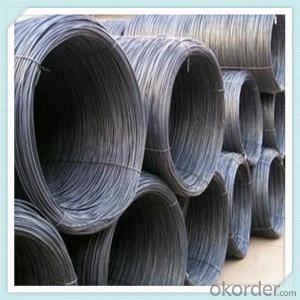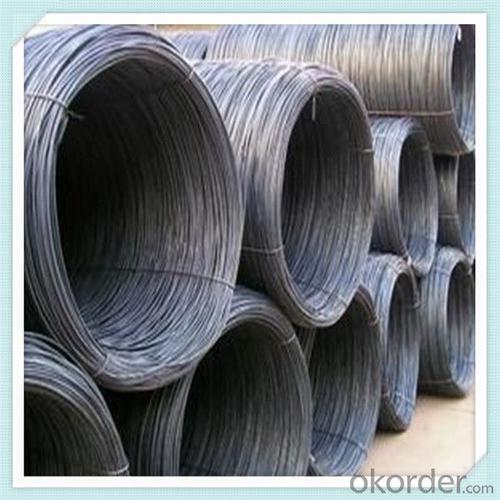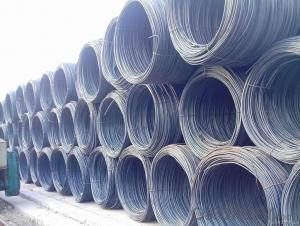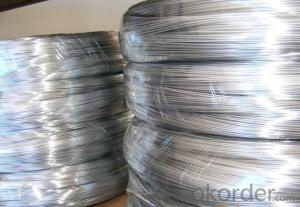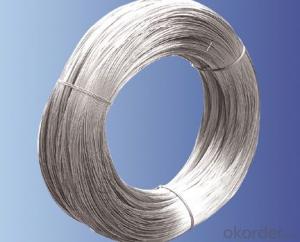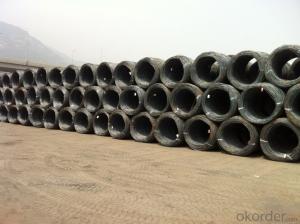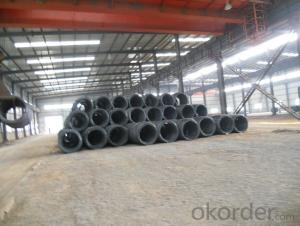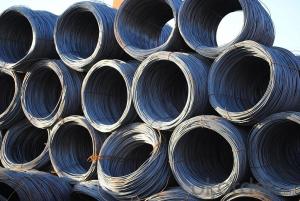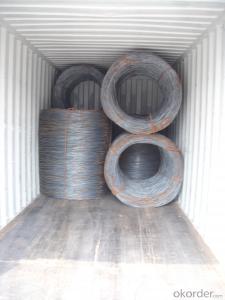Steel wire rod of good quality sale directly for mill
- Loading Port:
- Guangzhou
- Payment Terms:
- TT OR LC
- Min Order Qty:
- 100 m.t.
- Supply Capability:
- 11592 m.t./month
OKorder Service Pledge
OKorder Financial Service
You Might Also Like
Specification
Wire rod is used for many different products. Depending upon how it is cold formed and heat treated, wire
is used, for example, to produce not only wire ropes, barbed wire, wire mesh and nails, but also springs,
welded wire mesh and reinforcement wire.
Features
1、Pure steel quality, stable chemical contents, small tolerance.
2、Constant Quality, good drawing performance.
3、High dimension accuracy degree, accuracy degree of Level C up to 80%, smooth surface, less scale,
easy to be pickled.
4、Automatic bundling with 4 lines by Machine in tidy and good looks
5、Big high quality percentage, small coil percentage, and heavy coil weight for Hard Coil.
6、High sorbitizing percentage.
Product Description :
Standard | AISI, ASTM, BS, DIN, GB, JIS |
Material/steel grade | Q195-Q235,SAE1006B,SAE1006CR, SAE1008B, SAE1008CR, SAE1010B, SAE1018B, or according to customers requirements |
Wire Gauge | 5.5-12mm |
Coil weight | 1.8-2.1mts |
MOQ | 25MT |
Delivery Time | 15-30 days after receipt of L/C or deposit by T/T |
Packing | In coil and load in container, if large quantity, by bulk vessel; Can be packed as customers' special requirements |
Payment terms | 1).100% irrevocable L/C at sight. 2).30% T/T prepaid and the balance against the copy of B/L. 3).30% T/T prepaid and the balance against L/C |
Application | widely used in machinery parts, manufacturing industry, electronics industry, metal tools and others |
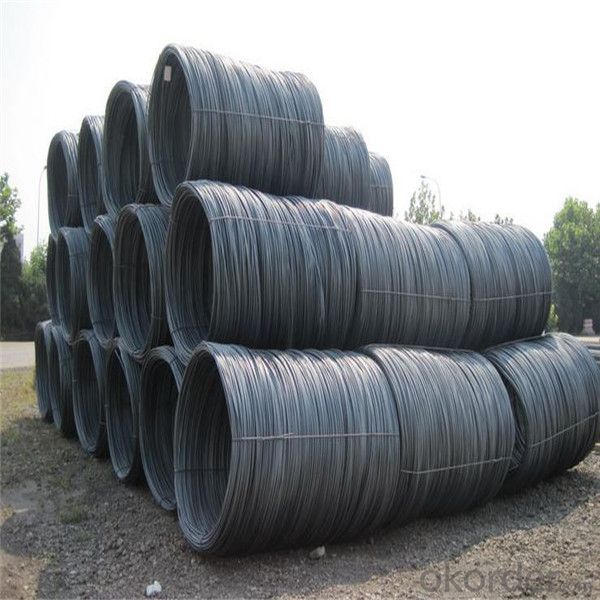

Application :
It generally used in braiding the hose for bathing product and machinery. With it
good flexibility, resistant to high temperature and resistant to corrosion, it
used widely in many industries.
Packing :
Hot-rolled wire rod is held in a unit with at least four steel straps in the
transverse direction and transported and stored without further packaging.
Before
the steel strapping is applied, the wire rod must be sufficiently compressed.
The strapping is fixed in the transverse direction with a single circumferential
strap so that the strapping does not slip and cause the coil to come apart.
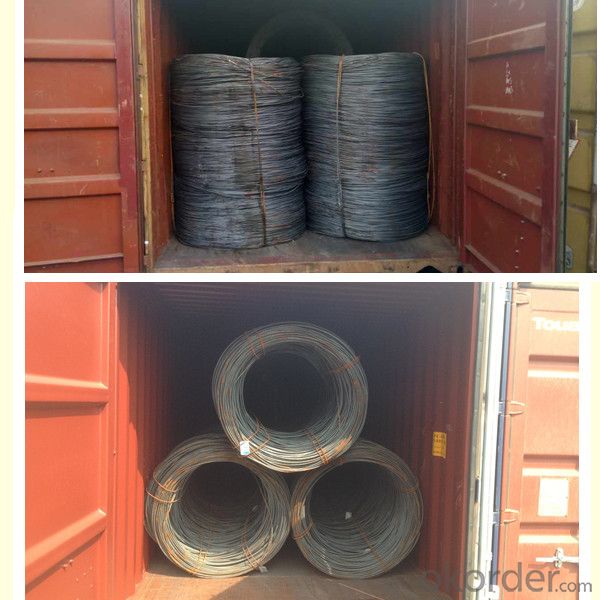
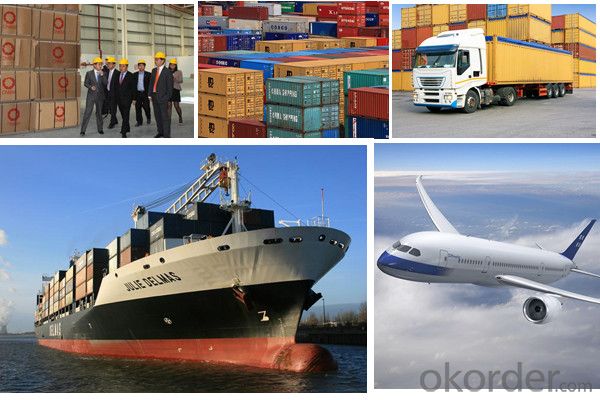
Our service:
(1) We cooperate with famous factories with advanced equipment and well trained workers.
(2) We can provide factory price with trading company service.
(3) We continuously work on the improvement of our processes, guaranteeing
consistently high standards of quality to keep none compensation.
(4) We guarantee 24 hours response and 48 hours solution providing service.
(5) We accept small order quantity before formal cooperation.
(6) We deliver the agreed quality at the agreed time, reacting to changes in
customer wishes in a flexible way.
(7) Due to our volume and selling power, we have excellent freight rates with
shipping lines.
(8) We strive to always be fair and honest in our dealings with customers.
(9) We strive to work together with customers to achieve much more than we can
achieve alone.
(10) Through our passion and commitment we aim to be a market leader in all our
key markets. To maintain our position as market leader we must continue to add
value in all that we do.
FAQ:
1.Q: What's your MOQ(minimum order quantity)?
A: One full container, mixed acceptable .
2. Q: What's your packing methods?
A: Packed in bundle or bulk ..
3. Q: How can I buy CNBM products in my country?
A:Please send us an inquiry or email ,we will reply to you if there is distributor in your country
4. Q: Can we visit your factory?
A: Warmly welcome. Once we have your schedule, we will arrange the
professional sales team to follow up your case.
5. Q: How long does it take to get the product if i place an order?
A:With the process of your requirements,we will pack and deliver in 3
-7 days. If it is by sea shipment,it will take 15-45 days depending on different locations
- Q: How are steel wire rods used in the production of tire cords?
- Steel wire rods are commonly used in the production of tire cords as they provide essential strength and durability. The tire cords are essentially the reinforcement material embedded within the rubber of a tire, which helps to improve its structural integrity and resistance to wear and tear. To manufacture tire cords, steel wire rods undergo a series of processes. First, the rods are drawn through a die to reduce their diameter and increase their length. This process, known as wire drawing, helps to improve the tensile strength and flexibility of the steel wires. After wire drawing, the steel wire rods are further processed through a series of heat treatment methods to enhance their mechanical properties. This includes processes such as annealing, quenching, and tempering. These treatments help to improve the wire's strength, elasticity, and resistance to fatigue, making them suitable for the demanding conditions in which tires operate. Once the steel wire rods have been properly treated, they are then twisted or braided together to form the tire cords. These cords are typically arranged in a crisscross pattern, known as the bias angle, to provide optimal strength and stability to the tire. The cords are then embedded within the rubber layers during the tire manufacturing process. The presence of steel wire cords in tires ensures that they can withstand the forces exerted during vehicle operation, including cornering, acceleration, and braking. The cords help to distribute the load evenly across the tire, improving its handling, stability, and overall performance. Additionally, the steel cords also contribute to the puncture resistance and longevity of the tires, making them more reliable and durable. In summary, steel wire rods are essential in the production of tire cords, providing strength, durability, and resilience to the tires. Through various processes such as wire drawing, heat treatment, and twisting or braiding, steel wire rods are transformed into tire cords that enhance the structural integrity and performance of tires in a wide range of driving conditions.
- Q: What are the advantages of using steel wire rod in oil and gas applications?
- There are several advantages of using steel wire rods in oil and gas applications. Firstly, steel wire rods have high tensile strength, which makes them suitable for handling heavy loads and withstanding extreme conditions in the oil and gas industry. Secondly, steel wire rods have excellent corrosion resistance, ensuring a longer lifespan and reducing the need for frequent maintenance. Additionally, steel wire rods offer good flexibility and are easily bendable, allowing for easy installation and maneuverability in complex oil and gas systems. Lastly, steel wire rods have high thermal conductivity, which is crucial for efficient heat transfer in various oil and gas processes.
- Q: What are the different surface cleaning methods for steel wire rod?
- There are several surface cleaning methods that can be used for steel wire rods. These methods are designed to remove any impurities or contaminants on the surface of the wire, ensuring its cleanliness and enhancing its quality. Some of the different surface cleaning methods for steel wire rods include: 1. Mechanical cleaning: This method involves the use of mechanical abrasion to remove surface impurities. It can be done through processes such as wire brushing, sanding, or shot blasting. Mechanical cleaning is effective in removing rust, scale, or other loose particles from the surface of the wire rod. 2. Chemical cleaning: Chemical cleaning methods use various chemicals to dissolve or react with contaminants on the wire rod's surface. Acid pickling is a common chemical cleaning method used for steel wire rods, where the wire is immersed in an acid solution to remove oxide layers, scale, or other impurities. Alkaline cleaning is another option, which uses alkaline solutions to remove organic contaminants. 3. Electrochemical cleaning: This method involves the use of an electrical current to remove impurities from the wire rod's surface. Electrochemical cleaning processes, such as electrochemical pickling or electrocleaning, use an electrolyte solution and an electric current to dissolve or dislodge contaminants. This method is often used for stainless steel wire rods to maintain their corrosion resistance. 4. Ultrasonic cleaning: Ultrasonic cleaning utilizes high-frequency sound waves to create microscopic bubbles in a cleaning solution. These bubbles, known as cavitation, implode on the surface of the wire rod, effectively removing contaminants. Ultrasonic cleaning is particularly effective in removing oils, greases, or other organic substances from the wire rod's surface. 5. Steam cleaning: Steam cleaning involves the use of high-pressure steam to clean the surface of the wire rod. The steam's heat and pressure help to dislodge and remove contaminants. This method is often used for wire rods that are heavily contaminated with oils, greases, or other sticky substances. It is important to note that the choice of surface cleaning method for steel wire rods depends on factors such as the type and severity of contamination, the desired level of cleanliness, and the specific requirements of the wire's end application. Each cleaning method has its own advantages and limitations, and it is crucial to select the most appropriate method to ensure the highest quality and performance of the steel wire rod.
- Q: What are the main factors influencing the supply and demand of steel wire rod?
- There are several main factors that influence the supply and demand of steel wire rod. 1. Economic growth: The overall economic growth of a country or region plays a significant role in determining the demand for steel wire rod. When the economy is growing, there is typically an increase in construction and infrastructure projects, which drives up the demand for steel wire rod. 2. Construction and infrastructure projects: The construction industry is one of the major consumers of steel wire rod. The demand for steel wire rod is influenced by the number and scale of construction and infrastructure projects, such as buildings, bridges, roads, and railways. The more construction projects there are, the higher the demand for steel wire rod. 3. Automotive industry: The automotive industry is another major consumer of steel wire rod. The demand for steel wire rod in this industry is influenced by factors such as consumer demand for automobiles, technological advancements, and government regulations related to automotive safety and emissions. The production of automobiles requires steel wire rod for various components, including suspension systems, engine parts, and reinforcements. 4. Manufacturing sector: The demand for steel wire rod is also influenced by the overall manufacturing sector. Steel wire rod is used in various manufacturing processes and industries, such as machinery, appliances, electrical equipment, and furniture. The level of manufacturing activity and the demand for goods produced by these industries affect the demand for steel wire rod. 5. Raw material availability and cost: The supply of steel wire rod is influenced by the availability and cost of raw materials, particularly iron ore and scrap metal. Changes in the availability or cost of these raw materials can impact the production and supply of steel wire rod. Additionally, fluctuations in energy prices, transportation costs, and other input costs can also affect the supply of steel wire rod. 6. International trade and tariffs: Global steel wire rod supply and demand are influenced by international trade and tariffs. Trade policies and tariffs imposed by countries can impact the import and export of steel wire rod, which in turn affects the supply and demand dynamics. Trade disputes and protectionist measures can disrupt the global steel wire rod market and create uncertainties in supply and demand. Overall, the supply and demand of steel wire rod are influenced by economic growth, construction and infrastructure projects, the automotive industry, the manufacturing sector, raw material availability and cost, and international trade and tariffs. These factors interact with each other and can fluctuate over time, leading to changes in the supply and demand dynamics of steel wire rod.
- Q: What are the different types of steel wire rod surface finishes?
- There are several types of steel wire rod surface finishes, including black, galvanized, and coated.
- Q: What are the future prospects for the steel wire rod industry?
- The future prospects for the steel wire rod industry are promising, with steady growth anticipated due to increasing demand from various sectors such as construction, automotive, and manufacturing. The industry is expected to benefit from infrastructure development projects, urbanization, and the growing emphasis on renewable energy. Technological advancements and innovation in production processes will further enhance efficiency and product quality. However, challenges such as fluctuating raw material prices and competition from substitute materials need to be addressed to ensure sustained growth in the steel wire rod industry.
- Q: How is steel wire rod transported?
- Steel wire rods are typically transported using a variety of transportation modes, depending on the distance and logistical factors involved. The most commonly used methods include rail, truck, and sea transportation. When it comes to long-distance transportation of steel wire rods, rail transportation is often the preferred option. The wire rods are loaded onto railcars, either in coils or bundles, and are secured using straps or other fastening methods to ensure stability during transit. Rail transport offers a cost-effective and efficient means of transportation, particularly for large quantities of wire rods. For shorter distances or when delivery needs to be made to specific locations that are inaccessible by rail, truck transportation is commonly employed. The wire rods are loaded onto flatbed trucks, either individually or in bundles, and are secured using chains or straps to prevent any shifting during transportation. This method allows for flexible delivery schedules and direct transport to the desired destination. In the case of international transportation, especially for long distances across oceans, sea transportation is utilized. The wire rods are typically loaded into shipping containers, either bundled or in coils, and then placed onto cargo ships. This method enables the transportation of large quantities of wire rods at once and proves to be cost-effective for long-haul journeys. Regardless of the chosen mode of transportation, it is crucial to ensure proper packaging and securing of the steel wire rods to prevent any damage or accidents during transit. Additionally, compliance with transportation regulations, including weight restrictions and safety guidelines, is essential to ensure a smooth and safe transportation process for steel wire rods.
- Q: What are the different types of packaging options available for steel wire rod?
- There are several different packaging options available for steel wire rod. The choice of packaging depends on factors such as the size and weight of the wire rod, its intended use, and the preferences of the buyer or manufacturer. One common packaging option for steel wire rod is coil packaging. In this method, the wire rod is coiled into a circular shape and then tightly wrapped with plastic or steel straps to secure it. Coils are often used for smaller diameter wire rods and are convenient for transportation and storage. Another packaging option is bundle packaging. In this method, several pieces of wire rod are bundled together and tightly bound with steel straps. Bundles are typically used for larger diameter wire rods and provide stability during transportation and handling. In addition to coils and bundles, steel wire rod can also be packaged in wooden crates or pallets. This method provides extra protection during transportation and can be used for both small and large diameter wire rods. Wooden packaging is often preferred when the wire rod needs to be shipped over long distances or stored for extended periods of time. Finally, some manufacturers may offer custom packaging options based on specific requirements. This could include special wrapping materials, additional protective measures, or unique packaging designs. Overall, the different types of packaging options available for steel wire rod ensure that the product is handled, transported, and stored in a safe and efficient manner, while also meeting the specific needs of the buyer or manufacturer.
- Q: How are steel wire rods used in the production of fishing lines?
- Steel wire rods are used in the production of fishing lines to provide strength and durability. These rods serve as the core or backbone of the fishing line, providing it with the necessary tensile strength to withstand the weight and pressure exerted by large fish. The steel wire rods used in fishing lines are typically made from high-quality stainless steel, which ensures resistance to corrosion and rust. This is crucial as fishing lines are constantly exposed to water and moisture, which can degrade the material over time. During the manufacturing process, the steel wire rods are coated with a protective layer, such as nylon or polymer, to enhance their performance and make them more suitable for fishing purposes. This coating not only provides additional strength but also increases the line's flexibility, making it easier to cast and retrieve. The steel wire rods are also responsible for determining the fishing line's overall diameter and weight. Thicker rods will result in a heavier and stronger line, while thinner rods will produce a lighter and more sensitive line. This allows anglers to choose a fishing line that best suits their specific needs and fishing conditions. Moreover, the use of steel wire rods in fishing lines provides increased sensitivity, allowing anglers to detect even the slightest nibbles or movements by the fish. This is especially important in situations where fish are more cautious and require a delicate approach. In summary, steel wire rods play a vital role in the production of fishing lines by providing the necessary strength, durability, and sensitivity. They serve as the foundation of the line, ensuring it can withstand the weight of large fish and resist the effects of water and corrosion.
- Q: How are steel wire rods used in the production of wire ropes for ships?
- Steel wire rods are of utmost importance in manufacturing wire ropes for ships. These rods serve as the primary material for producing wire ropes. To begin with, steel wire rods undergo a series of processes to convert them into wire strands. This entails drawing the rods through multiple dies to decrease their diameter and increase their length. This process ultimately forms thin and elongated wire strands. Subsequently, these wire strands are twisted together to form a cable core. The number of strands used and the direction of the twist depend on the specific requirements of the wire rope. This cable core provides the foundation and strength for the wire rope. Once the cable core is established, it is typically enveloped with an outer layer known as the wire rope's outer strands. These outer strands are also produced using steel wire rods. They are twisted around the cable core in a specific pattern to ensure strength, flexibility, and durability. The utilization of steel wire rods in manufacturing wire ropes for ships is crucial due to the exceptional properties of the material. Steel is renowned for its high tensile strength, resistance to corrosion, and durability, making it an ideal choice for maritime applications. These characteristics enable wire ropes made from steel wire rods to withstand the extreme forces and harsh environments encountered at sea. In conclusion, steel wire rods play a vital role in the production of wire ropes for ships. These rods are transformed into wire strands, which are then twisted together to create the cable core. The cable core is further encased with outer strands, resulting in a robust and resilient wire rope capable of enduring the demanding conditions of maritime operations.
Send your message to us
Steel wire rod of good quality sale directly for mill
- Loading Port:
- Guangzhou
- Payment Terms:
- TT OR LC
- Min Order Qty:
- 100 m.t.
- Supply Capability:
- 11592 m.t./month
OKorder Service Pledge
OKorder Financial Service
Similar products
Hot products
Hot Searches
Related keywords
